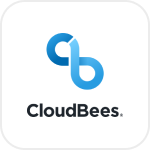
- Overview
- Configuration
CloudBees
Automate user creation with CloudBees and AD integration
CloudBees is an enterprise level DevOps platform that helps organizations streamline software development and delivery by automating and managing continuous integration CI/CD processes. The automation of user creation and synchronizing user details between CloudBees and AD ensures that development teams can quickly access the tools they need to collaborate and manage continuous integration and delivery processes, while IT teams can maintain accurate and secure user data across the organization.
Automated user account creation
When a new user is added to CloudBees, ADManager Plus automatically creates the corresponding user account in AD, as well as in related systems like Exchange and Microsoft 365 and ensure that employees have timely access to the resources they need from the moment they are onboarded in CloudBees.
User data synchronization
Ensures that user records remain consistent and accurate across all platforms. Any updates to user information in AD such as changes to roles, departments, or contact information are automatically synchronized with CloudBees.
How to integrate ADManager Plus and Cloudbees
Prerequisites:
Please ensure to provide the bearer token to retrieve desired information and perform tasks in CloudBees. Refer to CloudBees API references for more details.
Privileges:
To import users (inbound action): Ensure the account used for authorization has permission to read all user accounts.
To perform any action or query in CloudBees (outbound action): Ensure the account used for authorization has permission to perform the desired action.
Note: ADManager Plus comes with a preconfigured set of APIs that helps perform basic actions with the integration. If the action you require is not available, please gather the necessary API details from the CloudBees API documentation to configure under inbound/outbound webhooks to perform the required actions.Authorization configuration
- Log in to ADManager Plus and navigate to the Automation tab.
- In the left pane, under Configuration, click Application Integrations.
- Under Enterprise Applications, click CloudBees.
- Toggle the Enable CloudBees Integration button on.
- In the CloudBees Configuration page, click Authorization.
- Perform the steps to generate Bearer token in CloudBees and paste the Bearer token in the Value field.
- Click Configure.
Inbound webhook configuration
Inbound webhook enables you to fetch user data from CloudBees to ADManager Plus. The attribute mapping configured in this section can be selected as the data source during automation configuration. To configure an inbound webhook for CloudBees:
- Under Inbound Webhook, click CloudBees Endpoint Configuration.
-
In the Endpoint Configuration tab, an endpoint, CloudBees USERS ENDPOINT, comes preconfigured with an Endpoint URL, API Method, Headers, and Parameters fields to fetch user accounts from Sentry.
Note:
- The API key value pair is preconfigured as a header for authenticating API requests as configured during Authorization Configuration.
- Macros: You can add macros to your endpoint configuration to dynamically change it as per your requirement using the macro chooser component
- Refer to CloudBees's API references and configure additional headers and parameters, if required.
-
Click Test & Save. A response window will display all the requested parameters that can be fetched using the API call. After verifying if the requested parameters have been called to action, click Proceed.
Note:
- Refer to CloudBees's API references to know the Parameters that must be configured to fetch only specific parameters.
- You can configure multiple endpoints for CloudBees using the + Add API endpoint button. Click here to learn how.
- Click Data Source - LDAP Attribute Mapping to match endpoints and to map AD LDAP attributes with the respective attributes in CloudBees.
- Click + Add New Configuration and perform the following:
- Enter the Configuration Name and Description and select the Automation Category from the drop-down menu.
- In the Select Endpoint field, select the desired endpoint and a Primary Key that is unique to a user (e.g. employeeIdentifier). Note: When multiple endpoints are configured, this attribute must hold the same value in all the endpoints.
- In the Attribute Mapping field, select the attribute from the LDAP Attribute Name drop-down menu and map it with the respective attribute in CloudBees.
- If you would like to create a new custom format for this, click Add New Format.
- Click Save.
Outbound webhook configuration
Outbound webhook enables you to send changes made in AD to CloudBees, and carry out tasks in CloudBees—all from ADManager Plus. The webhooks configured in this section can be included in Orchestration Templates, which in turn can be used during event-driven and scheduled automations. They can also be applied directly on desired users to perform a sequence of actions on them (Management > Advanced Management > Orchestration).To configure outbound webhooks for CloudBees:
- Under Outbound Webhook, click CloudBees Webhook Configuration.
- Click + Add Webhook.
- Enter a name and description for this webhook.
- Decide on the action that has to be performed and refer to CloudBees's API references for the API details, such as URL, and the headers, parameters, and other requirements that will be needed.
- Select the HTTP method that will enable you to perform the desired action on the endpoint from the drop-down menu.
- Enter the endpoint URL.
- Configure the Headers, Parameters, and Message Type in the appropriate format based on the API call that you would like to perform.
- Click Test and Save.
- A pop-up window will then display a list of AD users and groups to test the configured API call. Select the desired user or group over which this API request has to be tested and click OK. This will make a real time call to the endpoint URL, and the selected objects' will be modified as per the configuration.
- The webhook response and request details will then be displayed. Verify them for the expected API behavior and click Save.